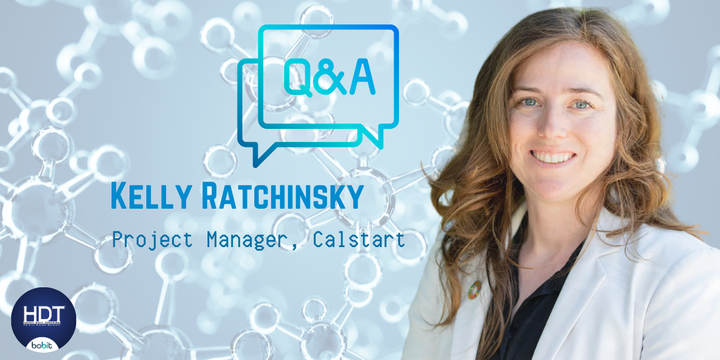Trucker Access › Forums › Diesel News › Q&A: Hydrogen Infrastructure Funding with Calstart – Fuel Smarts
- This topic has 0 replies, 1 voice, and was last updated 8 months, 4 weeks ago by
 EazyRiDer66.
EazyRiDer66.
-
AuthorPosts
-
July 6, 2024 at 5:45 am #28743
 EazyRiDer66Keymaster
EazyRiDer66Keymaster

Kelly Ratchinsky is Calstart’s technical project manager for hydrogen infrastructure.
There are two perennial complaints surrounding the move to zero-emissions transport: the cost of the equipment and the paucity of production and distribution infrastructure. This applies to both battery electric and fuel cell electric trucks.
Calstart is working to accelerates the pace of technology adoption through programs like Zero-Emission Commercial Vehicles (EnergIIZE) hydrogen funding lane. The program is intended to support hydrogen medium- and heavy-duty as well as off-road vehicle infrastructure.
So, what’s in this for the trucking industry?
Kelly Ratchinsky is Calstart’s technical project manager for hydrogen infrastructure. In this interview, she shares her insights with HDT Equipment Editor, Jim Park on how she believes this transition will unfold.
Ratchinsky outlines what she envisions the future of the medium- and heavy-duty transportation industry will look like using hydrogen powered vehicles, and describes the funding initiatives already in place to support that development.
This interview has been lightly edited for clarity.
HDT: There’s here’s a lot going on in California when it comes to hydrogen infrastructure and hydrogen fueling stations. What can you tell us about Calstart’s part in all this?
Ratchinsky: Yes, there is, and Calstart is the spearhead within the United States, certainly around this topic. We have been operating out of California for the last 30 years and supporting stakeholders with vehicle vouchers towards fuel cell electric trucks, as well as permanent infrastructure for hydrogen fueling stations.
We are the go-between of the state agency and the millions of dollars that they are putting into these types of projects. For example, in April, Calstart awarded $16 million to 10 applicants through the EnergIIZE Hydrogen funding lane to support the growth of hydrogen production and distribution.
HDT: What is the current state of hydrogen infrastructure in the Golden State?
Ratchinsky: Right now, there are clusters of hydrogen fueling stations, both light duty and medium heavy duty, in the Port of Los Angeles, Long Beach area, and also in that San Francisco, Oakland area.
The market is dominated with light-duty hydrogen fueling stations, which are not ideal for fueling trucks. So, when we filter those away, you see between four and six heavy-duty fueling stations that are up and live. And aside from the trucks, there are over 200 fuel cell electric buses that are operating in the state of California. Public transit is a key part of this market.
We are now focusing on how we can support trucking. The focus over the last few years, and especially this year, has been drayage in the California market. State agencies like the California Air Resources Board and the California Energy Commission are focused on supporting small fleets that want to switch to zero emission. There are certain policies coming down the line where they would be required to run zero emission trucks.
HDT: What are some of the challenges we’re facing in expanding the hydrogen infrastructure in Southern California?
Ratchinsky: The greatest challenge is cost due to the specialized equipment that’s needed. Equipment delays, which aligns with the battery electric equipment delays you would expect, like transformers and switch gear delays, because those are also needed in this context.
There’s a supply chain logistic challenge as well, like getting the hydrogen to the fueling site. They should be relatively close together to support economic feasibility and permitting and regulations.
Permitting is a problem too, even in the state of California. It still takes about a year, depending on which region you’re in in California, 10 to 12 months. That impacts the construction timeline to upwards of two or three years to actually get brick and mortar in the ground.
And the final piece is education, getting to the small fleets, the utilities and all of the stakeholders that are involved.
HDT: How does Calstart plan to start growing, A: the demand, and B: the supply infrastructure to support the demand?
Ratchinsky: The Energize hydrogen funding lane has been around for three iterations now. Our role is very much supporting the state funds to get to quality projects. And we support the states in return to understand what’s happening with industry.
So, we sit between industry and the states and we try to support the incentives to get into the hands of companies. And we listen to what the companies are saying, and the fleets are saying about their hurdles. We communicate that back to the states.
HDT: What are you hearing from fleets in terms of what they need to take the next step?
Ratchinsky: Well, Calstart does host interviews with fleets of different sizes. We did a study last year, I believe. I wasn’t involved with it specifically where we interviewed a number of fleets. And what we heard back from those fleets is that they didn’t know about hydrogen as an option.
They’re interested in going to zero emissions and even interested to pilot technologies it if there’s support externally for them.
From Calstart side, we see pilots happening, right? They’re typically one year with the opportunity to expand to two years, but what we haven’t seen yet in the market and what we’d like to work with fleets on is doing is a five-year pilot so we can actually see that total cost of ownership and the maintenance rate. We don’t know that for fuel cell electric trucks.
HDT: Can you share some of your insights into the funding mechanisms and the investment opportunities that are opening up now? A lot of people want into this market.
Ratchinsky: There are a few I’d like to highlight here. The first being the funding finder tool on Calstart’s website. Because you can see not just Calstart’s funding, but everything that we have been able to collate on what’s available out there for small fleets and for developers looking to purchase vehicles and infrastructure.
The second one I’ve been mentioning throughout, which is that HVIP medium heavy duty vehicle voucher incentive project.
It is funded by the California Air Resources Board and it’s administered by Calstart. Vehicles that qualify for the HVIP catalog are eligible for incentives typically $120,000 up to $240,000 with different plus-ups for hydrogen fuel cell vehicles.
And as well, something brand new out of the gate is Port of Long Beach and Port of Los Angeles have a port plus-up that can be stacked with HVIP. If anyone’s interested to learn more about that, you can reach out to Calstart at infrastructure @ Calstart.org and I’m happy to respond.
The final piece I’ll share is the Energize program. It’s a $276 million program in financial incentives in the state of California. And I’ve been speaking primarily about the hydrogen lane because that’s the one I have oversight on, but we do four different lanes each year.
And the other three are tied to battery electric vehicles in the medium- to heavy-duty space. So please go ahead and check that out there. We run that program yearly still, and there’ll be a launch this quarter for hydrogen and then again in the next two quarters.
HDT: Are you involved at all with the growth of renewable green hydrogen in California? Are you dipping your toe into that pond?
Ratchinsky: In my previous career, in my personal previous career, yes, but less so from the Calstart perspective.
That is a key focus for the state of California. However, something that we need to take a deep look into is the carbon intensity score to generate the various varieties of hydrogen and pair that with the delivery of the fuel to the site because that has emissions as well. And then pair that with the tailpipe emissions in order to get a clear picture. And that is something that our team is working on now.
The California state grid has a CI score, a carbon intensity score of about 80, which pushes the electrolysis CI score up as well, right? Because if you have a baseline of 80, then it’s higher than zero.
A lot of people think CI score of hydrogen generation through electrolysis is zero, but that’s only if it’s paired with the solar field or renewable hydrogen source. [Grid-powered electrolysis] actually has a higher CI score than steam methane reforming in some cases.
HDT: Do you have any other message you’d like to get across to the reader?
Ratchinsky: We are still really focused on reducing emissions from the port areas because of the disadvantage communities that surround them. We’re driven to have cleaner action plans, for example, and to force people coming in and out of the ports to have zero emissions, both on the vessel side and on the truck side.
We are also looking at logical corridors for trucking. The key ones I think will be between California and Houston. There’s a federal hydrogen hub going into Houston, and we have strong present-day operations happening between the two.
We are also looking at the I -15 corridor which goes to Las Vegas, because that’s a key port. And I -5, connecting North and South California. Within California, that’s a key focus. There’s already some activity in the San Joaquin Valley region between San Francisco and Los Angeles. They already have little clusters there; we’d like to connect them.
And then we’ll be looking at goods movement into the rest of the U .S., and the I-95 corridor specifically. Calstart is already supporting those stakeholders to think about multi-fuel sites where we have battery electric charging and hydrogen fueling together for Class 8 trucks. We’re looking forward to that.
-
AuthorPosts
- You must be logged in to reply to this topic.